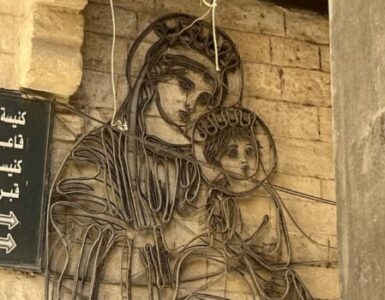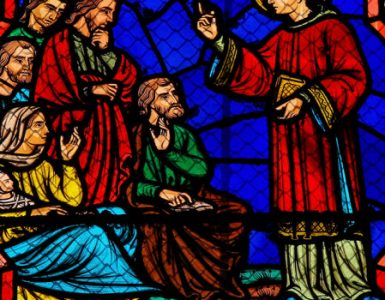Viewing and pondering sacred art offers the faithful a great way to prepare for the birth of Our Blessed Lord at Christmas. This series of articles will highlight several pieces of art related to the Gospel readings of this year’s lectionary cycle, as well as two pieces related to the week leading to Christmas. Each of these pieces of art allows us to reflect deeply on God’s plan for our lives, and to be prepared for the joyful celebration of Our Lord’s Nativity.
The Gospel reading for the Fourth Sunday of Advent tells us “how the birth of Jesus came about.” First, we hear of Mary’s mysterious and divine pregnancy. Then, we hear about the decision Joseph made to divorce Mary quietly, because “he was a righteous man.” Next, we hear about the appearance of an angel in Joseph’s dream, telling the young husband to “take Mary your wife into your home.” After the description of the dream, we receive the author’s commentary that this whole episode was the fulfillment of Isaiah’s prophecy about Emmanuel, “God with us.” Finally, we hear of Joseph’s decision after he awoke, the reversal of his original decision (Matthew 1:18-24).
St. Joseph’s Dream (El Sueño de San José) is one of Francisco Goya’s earliest paintings, from the early 1770s. Like the biblical passage, the painting is simple and understated. Yet, at the same time, it is clear and powerful. Right away, this painting draws viewers into the dramatic scene in Nazareth. In both cases, the Gospel scene and the painting, the few necessary details offer viewers ample opportunity for meditation during the final week of Advent, leading up to the Nativity of Our Blessed Lord.

At the left-hand edge of the painting is a pregnant Mary. In this scene, Mary looks downcast and worried. One can imagine how anxious this teenage girl must have felt at this point in the story. Sure, she had ultimate trust in the Lord, but she might have worried that she would be divorced and ostracized in the small Jewish village. In these last days of Advent, we can ask the Lord to rescue us from our anxiety. We can ask him to grant us the grace to grow in trust, learning to have faith that He provides what we need in exactly the right timing.
At the opposite edge of the painting, we see the sleeping Joseph. One of the first things we note is St. Joseph’s age and physical condition. In Goya’s rendition of this scene, Joseph is young (no more than middle-aged) and virile. This coincides with a movement in recent generations to depict Joseph as a man who would walk to Bethlehem and Egypt and back; and who could be a strong protector and provider for the Holy Family of Nazareth. We can imagine that Joseph, in this moment, was exhausted not only from work, but also from agonizing over his difficult decision. Advent offers each of us an opportunity to make two requests of the Lord, regardless of age. We can ask the Lord to help us surrender and rest as we make difficult decisions; and we can ask the Lord to fill us with the courage of St. Joseph, which was the courage to act on the message of the Lord.
Beside Joseph as he sleeps are a walking stick and some kind of red garment, both meant to signify Joseph’s future in his relationship to Jesus and Mary. He would be told to walk from Nazareth to Bethlehem for a census, with his wife who was near to delivering Jesus. Soon after that trek, Joseph would be told in another dream to take Jesus and Mary to Egypt for safety, an even more arduous pilgrimage. For both of these, Joseph would need courage: courage to face the dangers of the road; and the courage to accept the social ramifications of his decision. That is the courage of martyrdom. Each of us, regardless of age or life condition, needs to ask for such courage.
In the center of the painting is the messenger of the Lord. This angel’s wings seem to bring us directly into Joseph’s dreamy sleep. The angel’s left hand reaches up to Heaven, while the right hand rests on Joseph’s shoulder, signifying that the dream was a message conveyed directly from God to this man. During Advent, and as I ponder this piece of art, I ought to ask the Lord if there is any particular message that the Lord desires me to receive. I ought to ask the Lord to overcome my lack of awareness, even by the miraculous means of coming in a dream, if it is necessary.
We also can learn something important from Goya’s use of color. Joseph is covered by a beige or brown tunic. Only his sleeves bear a little bit of vibrant color. This might be intended to convey his humanity, and the fact that he was “a righteous man.” His original decision was based on human righteousness, but his deep connection to God offered a glimmer of hope. Mary wears a magenta garment and a blue shawl. This might be the artist’s attempt to convey that Mary was fully human, but that she was cloaked in divine grace by means of the Immaculate Conception. Finally, the angel is wrapped in a garment of blue and green hues. A viewer quickly notices the contrast between the angel and Joseph, while Mary bears qualities of both. This provides an opportunity for the faithful to ask for the grace to be transformed and become more attuned to the Divine Voice and divine ways; and to ask for Our Lady’s intercession in this process.
In this biblical narrative, the most hopeful part of the message is that Emmanuel, God with us, “will save his people from their sins.” This line offers hope and consolation because it helps us to remember that we don’t have to be the savior for ourselves or anyone else. Goya paints this reality well. Mary and Joseph are not active in this scene. They passively receive what God has to say and give. Thank goodness, during Advent, we can throw up our hands and admit that we don’t have all the answers or the ability to solve every problem. We can become passive receivers of His divine grace, His message, while He ministers to all our needs.
Come, Lord Jesus, be with us in our needs and our weaknesses!
✠
St. Joseph’s Dream is in the public domain.












